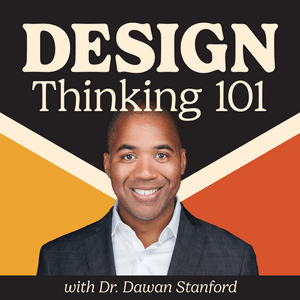Architecture + Decision Design + Learning Spaces + Strategy with Adam Griff — E142
In this episode, I explore how architectural thinking enhances strategic decision-making with Adam Griff. Our conversation reveals how his architectural background shapes his approach to helping higher education institutions navigate complex decisions and create flexible space solutions. We dig into the challenges of designing spaces that can adapt to unknown futures and discuss how universities can better integrate with their communities. I particularly love how Adam frames flexibility in building design as creating platforms for future adaptations rather than just multi-purpose spaces. We also explore the tension between academic and organizational decision-making and how to create and decide while delivering innovation in higher education. Questions This Episode Helps You Answer How does thinking like an architect help organizations make better strategic decisions? What makes flexibility essential in both physical spaces and organizational processes, and how can we intentionally design for it from the beginning? What elements create environments where good decisions emerge, and how can we support better decision-making outcomes? How do we determine whether physical space is the best solution for achieving our organizational goals, and what questions should we ask before investing in space? How can we think about buildings as adaptable platforms that support evolving human needs rather than fixed structures with predetermined uses? How might universities and colleges create meaningful connections between campus development and community growth that benefit both? What strategies help organizations balance the need for scholarly rigor with efficient administrative decision-making, and how can these different approaches work together effectively? Episode Highlights [00:00] Introduction and background on Adam Griff [01:38] How architectural thinking shapes strategic problem-solving [04:17] Managing diverse stakeholders in higher education contexts [05:35] Understanding people’s needs versus asking for solutions [07:31] Orchestrating organizational decision-making [09:13] The importance of decision-making culture in institutions [11:20] Building trust and managing participation in decisions [14:15] Creating shared understanding of evidence and good decisions [17:04] Balancing organizational conditions with decision quality [19:38] Making decisions with incomplete information [21:36] Academic versus administrative approaches to decisions [24:40] Rethinking flexibility in organizational strategy [25:25] Space as a medium for service delivery [26:51] Designing buildings as platforms for adaptation [29:14] Lifecycle costs and sustainable building design [30:48] Integration of campus and community development [33:31] Responding to demographic changes in higher education [35:33] Finding what is "uniquely possible" for institutions [39:12] Moving from master planning to scenario-based "playbooks" [41:09] Closing thoughts and connecting with Adam Questions to Help You Go Deeper Learning How does architectural thinking about constraints and systems change your approach to organizational challenges? What surprised you about our discussion of decision-making quality? Why? Leading How might you redesign decision-making environments in your organization? What would change if you approached strategic planning as creating a playbook rather than a rigid strategic plan? Applying What's one small experiment you could run next week to improve your team's decision-making space? Choose a current project or challenge. How might it benefit from thinking about systems and constraints like an architect? Practicing How will you incorporate the "Is space the right medium?" question into your solution development process? What is one idea from the episode that you will apply in the next two two weeks? Guest Resources Adam on LinkedIn Adam on Academia Gamification: How to Play Gensler Gensler Research & Insights Stewart Brand's "How Buildings Learn" The High Line, NYC Higher education demographic/enrollment cliff Scenario planning methodologies COM-B behavior change model Stranded assets Resources I Recommend DT101 Episodes Radical Participatory Design + Relationships in Complex Systems Inclusive Design with Victor Udoewa — DT101 E127 Talk to the Elephant: Design Learning for Behavior Change with Julie Dirksen — DT101 E131 Healthcare Design: Evidence-based, Business Fluent, and Change Prepared with Matt Van Der Tuyn — DT101 E140 Books Brown, Peter C., Henry L. Roediger, and Mark A. McDaniel. Make It Stick: The Science of Successful Learning. Cambridge, Mass: The Belknap Press of Harvard University Press, 2014. -- Orchestrating good decisions requires understanding how people learn. Before people can decide about something new they must learn the information they need to know to make a good decision and what constitutes a good decision in this context. Read chapter 8. Ariely, Dan. Predictably Irrational: The Hidden Forces That Shape Our Decisions. Revised and Expanded edition, First Harper Perennial edition published. Harper Business & Economics. New York: Harper Perennial, 2010. -- Ariely walks you through ways we make decisions that conflict with classic economic rationality, like: The Effect of Expectations: Our preconceptions and expectations significantly influence our experiences and decisions. For instance, people report greater pain relief from more expensive placebos, demonstrating how price can affect perceived value. The Cost of Ownership: Once we own something, we tend to overvalue it (the "endowment effect"). Heath, Chip, and Dan Heath. Decisive: How to Make Better Choices in Life and Work. New York: Random House Books, 2014. -- Don’t trust your gut. It hates you. You’ll learn how to slow down and avoid becoming a cautionary tale like the ones in this book. Kahneman, Daniel. Thinking, Fast and Slow. First paperback edition. Psychology/Economics. New York: Farrar, Straus and Giroux, 2013. -- "Thinking, Fast and Slow" reveals how our minds use both quick instincts and careful analysis to make choices, helping innovators design solutions that work with human psychology rather than against it. Thaler, Richard H., and Cass R. Sunstein. Nudge: Improving Decisions about Money, Health, and the Environment. Final edition. New York: Penguin Books, an imprint of Penguin Random House LLC, 2021. -- Nudge "Nudge" reveals how small changes in how choices are presented can dramatically impact decision-making and behavior at scale, while preserving freedom of choice. I'd love to hear what insights you're taking away from this exploration of architecture, strategy, and organizational design. Share your thoughts and stay updated at https://fluidhive.com/design-thinking-101-podcast/ Stay lucky ~ Dawan

